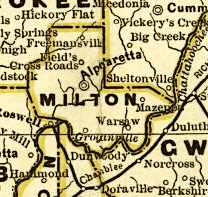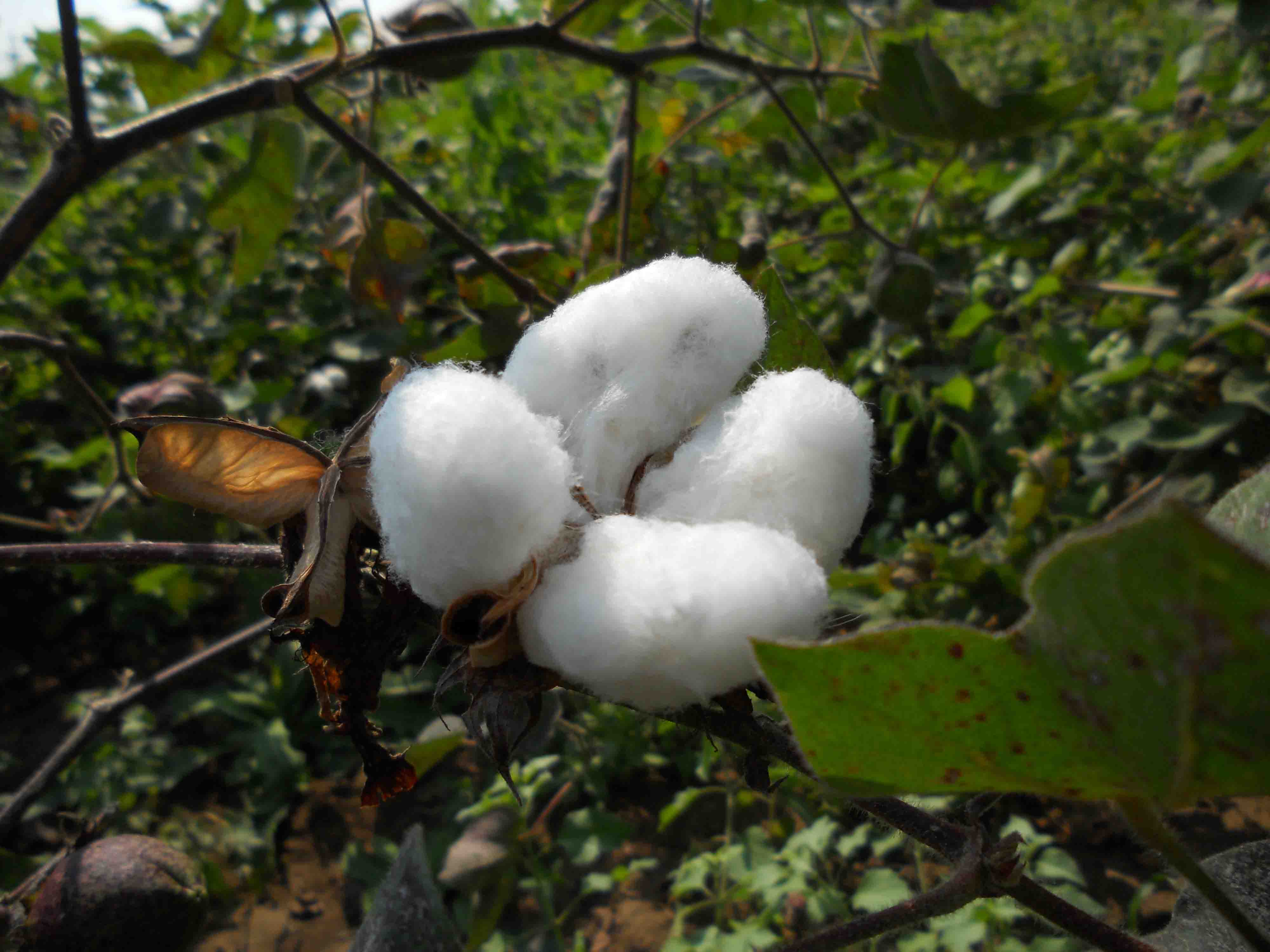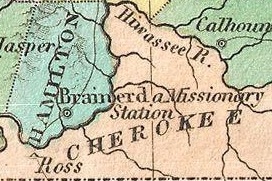|
Milton, Georgia
Milton is a city in Fulton County, Georgia, United States, located about 30 miles (48 km) north of downtown Atlanta. Incorporated on December 1, 2006, the population was 41,296 as of the 2020 census. Milton is one of the wealthiest cities in the state of Georgia and is known for its high quality of life, excellent schools, and affluent community. The city is named after Revolutionary War hero John Milton, who is also the namesake of the former Milton County that included modern-day Milton between 1857 and 1931. With over 39 square miles of land, much of it agriculturally zoned, Milton is characterized by its rural and equestrian heritage, spacious residential lots, and a small-town feel combined with the amenities of a metropolitan area. It is bordered by Cherokee and Forsyth counties, as well as the cities of Roswell and Alpharetta. History Early Inhabitants and European Settlement (1000-1832) The lands of what is now Milton, Georgia, were once the domain of the Cheroke ... [...More Info...] [...Related Items...] OR: [Wikipedia] [Google] [Baidu] |
City
A city is a human settlement of a substantial size. The term "city" has different meanings around the world and in some places the settlement can be very small. Even where the term is limited to larger settlements, there is no universally agreed definition of the lower boundary for their size. In a narrower sense, a city can be defined as a permanent and Urban density, densely populated place with administratively defined boundaries whose members work primarily on non-agricultural tasks. Cities generally have extensive systems for housing, transportation, sanitation, Public utilities, utilities, land use, Manufacturing, production of goods, and communication. Their density facilitates interaction between people, government organisations, government organizations, and businesses, sometimes benefiting different parties in the process, such as improving the efficiency of goods and service distribution. Historically, city dwellers have been a small proportion of humanity overall, bu ... [...More Info...] [...Related Items...] OR: [Wikipedia] [Google] [Baidu] |
Milton County, Georgia
Milton County was a county of the U.S. state of Georgia from to . It was created on December 18, 1857, from parts of northeastern Cobb, southeastern Cherokee, and southwestern Forsyth counties. The county was named for John Milton, Secretary of State of Georgia from 1777 to 1799. Alpharetta was the county seat until the end of 1931, when Milton was merged with Fulton County to save it from bankruptcy during the Great Depression. At that time, Campbell County, which had already gone bankrupt, was also ceded to Fulton, giving it its 70-mile (110 km) long irregular shape along the Chattahoochee River. Following the 1932 merger, the Cobb County town of Roswell was also ceded to Fulton four months later on May 9, 1932. The cession of Roswell (including everything east of Willeo Creek) made the new county more contiguous, though a very narrow strip (what is now the Dunwoody Panhandle of Sandy Springs, ceded to Milton from DeKalb) actually already connected the two sec ... [...More Info...] [...Related Items...] OR: [Wikipedia] [Google] [Baidu] |
Cash Crop
A cash crop, also called profit crop, is an Agriculture, agricultural crop which is grown to sell for profit. It is typically purchased by parties separate from a farm. The term is used to differentiate a marketed crop from a staple crop ("subsistence crop") in subsistence agriculture, which is one fed to the producer's own livestock or grown as food for the producer's family. In earlier times, cash crops were usually only a small (but vital) part of a farm's total yield, while today, especially in Developed country, developed countries and among Smallholding, smallholders almost all crops are mainly grown for revenue. In the Least developed country, least developed countries, cash crops are usually crops which attract demand in more developed nations, and hence have some export value. Prices for major cash crops are set in international trade markets with global markets, global scope, with some local variation (termed as "basis") based on Cargo, freight costs and local supply a ... [...More Info...] [...Related Items...] OR: [Wikipedia] [Google] [Baidu] |
Cotton
Cotton (), first recorded in ancient India, is a soft, fluffy staple fiber that grows in a boll, or protective case, around the seeds of the cotton plants of the genus '' Gossypium'' in the mallow family Malvaceae. The fiber is almost pure cellulose, and can contain minor percentages of waxes, fats, pectins, and water. Under natural conditions, the cotton bolls will increase the dispersal of the seeds. The plant is a shrub native to tropical and subtropical regions around the world, including the Americas, Africa, Egypt and India. The greatest diversity of wild cotton species is found in Mexico, followed by Australia and Africa. Cotton was independently domesticated in the Old and New Worlds. The fiber is most often spun into yarn or thread and used to make a soft, breathable, and durable textile. The use of cotton for fabric is known to date to prehistoric times; fragments of cotton fabric dated to the fifth millennium BC have been found in the Indus Valley civilizat ... [...More Info...] [...Related Items...] OR: [Wikipedia] [Google] [Baidu] |
Subsistence Agriculture
Subsistence agriculture occurs when farmers grow crops on smallholdings to meet the needs of themselves and their families. Subsistence agriculturalists target farm output for survival and for mostly local requirements. Planting decisions occur principally with an eye toward what the family will need during the coming year, and only secondarily toward market prices. Tony Waters, a professor of sociology, defines "subsistence peasants" as "people who grow what they eat, build their own houses, and live without regularly making purchases in the marketplace". Despite the self-sufficiency in subsistence farming, most subsistence farmers also participate in trade to some degree. Although their amount of trade as measured in cash is less than that of consumers in countries with modern complex markets, they use these markets mainly to obtain goods, not to generate income for food; these goods are typically not necessary for survival and may include sugar, iron roofing-sheets, bicycle ... [...More Info...] [...Related Items...] OR: [Wikipedia] [Google] [Baidu] |
Land Lottery
A land lottery or land ballot is a method of allocating land ownership or the right to occupy land by lot. Some examples are: * Moses' allocation of Promised Land territory to the Israelite tribes by lot, as mandated in Numbers 26:55 and 33:54 and effected by his successor Joshua in Joshua 13:6. * The Georgia Land Lotteries held between 1805 and 1833 * The allocation of land in the former Kiowa-Comanche and Apache reservation in Oklahoma Territory on August 6, 1901. * The allocation of reclaimed land at Tule Lake, California, to returning veteran homesteaders after World War II. It is reported that prospective settlers' names were drawn from a pickle jar because the number of applicants was greater than the number of homesteads available. Israelite land lottery combines allocation of land by lot with a distribution system allocating territory according to each tribe's adult male population size. The '' Pulpit Commentary'' suggests that the community "probably employed stones, ... [...More Info...] [...Related Items...] OR: [Wikipedia] [Google] [Baidu] |
Cherokee Removal
The Cherokee removal (May 25, 18381839), part of the Indian removal, refers to the forced displacement of an estimated 15,500 Cherokees and 1,500 African-American slaves from the U.S. states of Georgia, North Carolina, Tennessee and Alabama to the West according to the terms of the 1835 Treaty of New Echota. It is estimated that 3,500 Cherokees and African-American slaves died en route. The Cherokee have come to call the event ''Nu na da ul tsun yi'' (the place where they cried); another term is ''Tlo va sa'' (our removal). Neither phrase was used at the time, and both seem to be of Choctaw origin. Other American Indian groups in the American South, North, Midwest, Southwest, and the Plains regions were removed, some voluntarily, some reluctantly, and some by force. The Chickasaw, Choctaw, Muscogee ( Creek), and Cherokee were removed reluctantly. The Seminole in Florida resisted removal by the United States Army for decades (1817–1850) with guerrilla warfare, part of the ... [...More Info...] [...Related Items...] OR: [Wikipedia] [Google] [Baidu] |
Andrew Jackson
Andrew Jackson (March 15, 1767 – June 8, 1845) was the seventh president of the United States from 1829 to 1837. Before Presidency of Andrew Jackson, his presidency, he rose to fame as a general in the U.S. Army and served in both houses of the U.S. Congress. Jacksonian democracy, His political philosophy became the basis for the History of the Democratic Party (United States), Democratic Party. Jackson's legacy is controversial: he has been praised as an advocate for working Americans and Nullification crisis, preserving the union of states, and criticized for his racist policies, particularly towards Native Americans in the United States, Native Americans. Jackson was born in the colonial Carolinas before the American Revolutionary War. He became a American frontier, frontier lawyer and married Rachel Donelson Jackson, Rachel Donelson Robards. He briefly served in the U.S. House of Representatives and the U.S. Senate, representing Tennessee. After resigning, he served a ... [...More Info...] [...Related Items...] OR: [Wikipedia] [Google] [Baidu] |
Trail Of Tears
The Trail of Tears was the forced displacement of about 60,000 people of the " Five Civilized Tribes" between 1830 and 1850, and the additional thousands of Native Americans and their black slaves within that were ethnically cleansed by the United States government. As part of Indian removal, members of the Cherokee, Muscogee, Seminole, Chickasaw, and Choctaw nations were forcibly removed from their ancestral homelands in the Southeastern United States to newly designated Indian Territory west of the Mississippi River after the passage of the Indian Removal Act in 1830. The Cherokee removal in 1838 was the last forced removal east of the Mississippi and was brought on by the discovery of gold near Dahlonega, Georgia, in 1828, resulting in the Georgia Gold Rush. The relocated peoples suffered from exposure, disease, and starvation while en route to their newly designated Indian reserve. Thousands died from disease before reaching their destinations or shortly after. A variet ... [...More Info...] [...Related Items...] OR: [Wikipedia] [Google] [Baidu] |
Dahlonega, Georgia
Dahlonega ( ) is the county seat of Lumpkin County, Georgia, United States. As of the 2010 United States Census, 2010 census, the city had a population of 5,242, and in 2018 the population was estimated to be 6,884. Dahlonega is located at the north end of Georgia 400, Georgia highway 400, a freeway which connects Dahlonega to Atlanta. Dahlonega was named as one of the best places to retire by the publication ''Real Estate Scorecard''. The city is also a college town, home to the main campus of the University of North Georgia. Dahlonega was the site of the second major Gold Rush in the United States beginning in 1829. The Dahlonega Gold Museum Historic Site which is located in the middle of the public square, was originally built in 1836 as the Lumpkin County Courthouse. In 1849, when local gold miners were considering heading west to join the California Gold Rush, Dr. M. F. Stephenson, Matthew Fleming Stephenson, the assayer at the Dahlonega Branch Mint, tried to persuade ... [...More Info...] [...Related Items...] OR: [Wikipedia] [Google] [Baidu] |
Dahlonega Gold Rush
The Georgia Gold Rush was the second significant gold rush in the United States and the first in Georgia, and overshadowed the previous rush in North Carolina. It started in 1829 in present-day Lumpkin County near the county seat, Dahlonega, and soon spread through the North Georgia mountains, following the Georgia Gold Belt. By the early 1840s, gold became difficult to find. Many Georgia miners moved west when gold was found in the Sierra Nevada in 1848, starting the California Gold Rush. Since the 16th century, American Indians in Georgia told European explorers that the small amounts of gold which they possessed came from mountains of the interior. Some poorly documented accounts exist of Spanish or French mining gold in North Georgia between 1560 and 1690, but they are based on supposition and on rumors passed on by Indians. In summing up known sources, W.S. Yeates observed: "Many of these accounts and traditions seem to be quite plausible. Nevertheless, it is hardly pro ... [...More Info...] [...Related Items...] OR: [Wikipedia] [Google] [Baidu] |
Native American Trade
Native American trade refers to trade among the Indigenous peoples of the Americas, Indigenous people of North America and with European Settler, settlers. Trade with Europeans began before the colonial period, continuing through the 19th century and declining around 1937. The term Native American Trade in this context describes the people involved in the trade. The products involved varied by region and era. In most of Canada, the term is synonymous with the North American fur trade, fur trade, since fur for making beaver hats was by far the most valuable product of the trade, from the European point of view. Demand for other products resulted in trade in those items: Europeans asked for Deerskin trade, deerskin on the southeast coast of the United States, American bison, buffalo skins and meat, and pemmican on the Great Plains. In turn, Native American demand influenced the trade of goods brought by Europeans. Economic contact between Native Americans and European colonists be ... [...More Info...] [...Related Items...] OR: [Wikipedia] [Google] [Baidu] |








